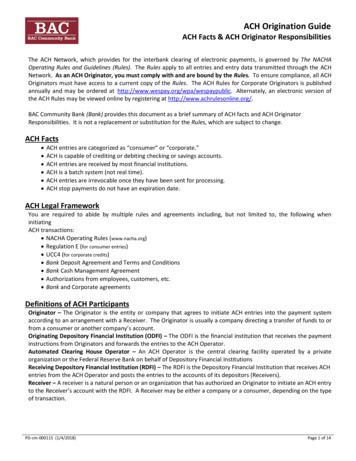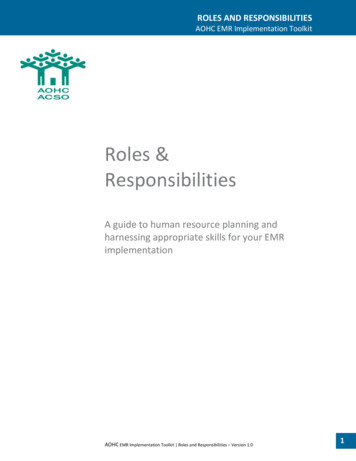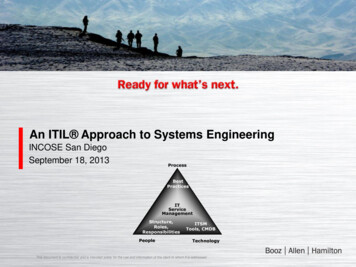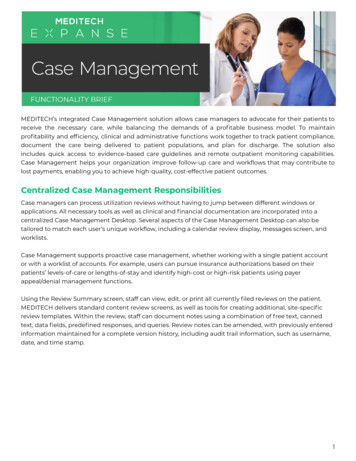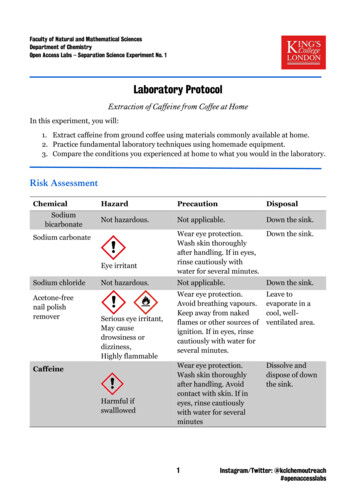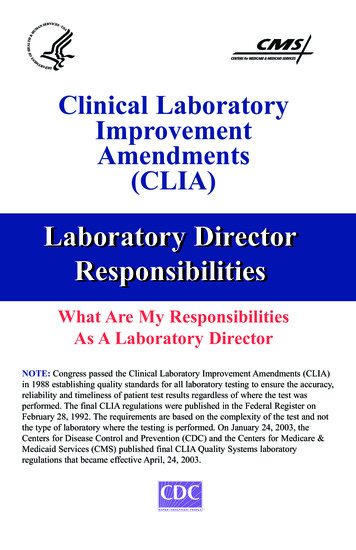
Transcription
Clinical LaboratoryImprovementAmendments(CLIA)Laboratory DirectorResponsibilitiesWhat Are My ResponsibilitiesAs A Laboratory DirectorNOTE: Congress passed the Clinical Laboratory Improvement Amendments (CLIA)in 1988 establishing quality standards for all laboratory testing to ensure the accuracy,reliability and timeliness of patient test results regardless of where the test wasperformed. The final CLIA regulations were published in the Federal Register onFebruary 28, 1992. The requirements are based on the complexity of the test and notthe type of laboratory where the testing is performed. On January 24, 2003, theCenters for Disease Control and Prevention (CDC) and the Centers for Medicare &Medicaid Services (CMS) published final CLIA Quality Systems laboratoryregulations that became effective April, 24, 2003.
IS IT SUFFICIENT THAT I MEET THE EXPERIENCE,EDUCATIONAL, AND TRAINING REQUIREMENTS FORA LABORATORY DIRECTOR UNDER CLIA?No, in addition you must meet the regulatory responsibilities outlinedbelow. You must demonstrate active involvement in the laboratory’soperation and be available to the laboratory staff, as needed.WHAT ARE MY OVERALL RESPONSIBILITIES?As laboratory director, you are responsible for the overall operation andadministration of the laboratory, including the employment of competentqualified personnel. Even though you have the option to delegate someof your responsibilities, you remain ultimately responsible and mustensure that all the duties are properly performed and applicable CLIAregulations are met. It is your responsibility to ensure that yourlaboratory develops and uses a quality system approach to laboratorytesting that provides accurate and reliable patient test results.WHAT IS THE QUALITY SYSTEM APPROACH?In the quality system approach, the laboratory focuses on comprehensiveand coordinated efforts to achieve accurate, reliable, and timely testingservices. The quality system approach includes all of your laboratory’spolicies, processes, procedures, and resources needed to achieveconsistent, high quality testing services. Integral to the quality systemapproach is quality assessment, which involves the following activities: ongoing monitoring of each testing process used in yourlaboratory in order to identify errors or potential problems thatcould result in errors; taking corrective action; and evaluating the corrective actions taken, to make sure that theywere effective and will prevent recurrence.1.
WHAT ARE THE RESPONSIBILITIES FOR WHICHI MUST MAINTAIN DIRECT OVERSIGHT ANDCANNOT DELEGATE TO OTHERS?As laboratory director, you must ensure that: testing systems in the laboratory provide quality services in allaspects of test performance, i.e., the preanalytic, analytic, andpostanalytic phases of testing and are appropriate for your patientpopulation; physical and environmental conditions of the laboratory are adequateand appropriate for the testing performed; the environment for employees is safe from physical, chemical, andbiological hazards and safety and biohazard requirements arefollowed; a general supervisor (high complexity testing) is available to provideday-to-day supervision of all testing personnel and reporting of testresults as well as provide on-site supervision for specific minimallyqualified testing personnel when they are performing highcomplexity testing; sufficient numbers of appropriately educated, experienced, and/ortrained personnel who provide appropriate consultation, properlysupervise, and accurately perform tests and report test results inaccordance with the written duties and responsibilities specified byyou, are employed by the laboratory; new test procedures are reviewed, included in the procedure manualand followed by personnel; and each employee’s responsibilities and duties are specified in writing.IN ADDITION TO LABORATORY DIRECTOR, WHAT ARETHE REQUIRED PERSONNEL POSITIONS FOR NONWAIVEDTESTING NAMED IN THE CLIA REQUIREMENTS?Moderate complexity testingTechnical consultantClinical consultantTesting personnel2.High complexity testingTechnical supervisorClinical consultantGeneral supervisorTesting personnel
NOTE: The responsibilities for a technical consultant for moderatecomplexity and a technical supervisor for high complexity testingare the same. The responsibilities for a clinical consultant formoderate complexity and high complexity testing are also the same.The personnel qualifications for these positions may be different dueto the need for specialized education, training and/or experience toaddress the higher level of test complexity.MAY I ASSUME THE RESPONSIBILITIES OF OTHERPOSITIONS REQUIRED IN THE CLIA REQUIREMENTS?As director, you may assume the responsibilities for any position namedin the CLIA requirements, such as clinical consultant, technicalconsultant (moderate complexity testing) or technical supervisor andgeneral supervisor (high complexity testing), as long as you meet thepersonnel qualification requirements of education, experience, andtraining for the position in order to fulfill the responsibilities.IF I CHOOSE NOT TO PERFORM THE RESPONSIBILITIESOF POSITIONS OTHER THAN DIRECTOR, MUST IDESIGNATE SEPARATE INDIVIDUALS FOR CLINICALCONSULTANT, TECHNICAL CONSULTANT OR TECHNICALSUPERVISOR, AND GENERAL SUPERVISOR?You may choose separate individuals for each position or haveindividuals serve in multiple positions, as long as those individuals canfulfill the responsibilities and meet the personnel qualifications for thepositions they are filling.WHICH RESPONSIBILITIES MAY I DELEGATEAND TO WHOM?As laboratory director, you may share some dual responsibilities withthe clinical consultant; therefore, you may delegate, in writing, theresponsibilities for ensuring: test reports include pertinent information for test interpretation, and availability for consultation concerning test results and theinterpretation of those results as they relate to specific patientconditions.3.
As laboratory director, you share some dual responsibilities with thetechnical consultant (moderate complexity) or technical supervisor(high complexity); therefore, you may delegate, in writing, theresponsibilities for ensuring: appropriate test method selection; adequate method verification in order to determine the accuracy andprecision of the test; enrollment of the laboratory in a CMS-approved proficiency testing(PT) program for the test performed; PT samples are tested in accordance with the CLIA requirements; PT results are returned within the time frames established by the PTprogram; PT reports are reviewed by the appropriate staff; corrective action plans are followed when PT results are found to beunacceptable or unsatisfactory; quality assessment and quality control programs are established andmaintained; acceptable analytical test performance are established and maintainedfor each test system; remedial actions are taken and documented when significantdeviations from the laboratory’s established performancecharacteristics are identified, and patient test results are reported onlywhen the system is functioning properly; personnel have been appropriately trained and demonstratecompetency prior to testing patient specimens; policies and procedures are established for monitoring personnelcompetency in all phases (preanalytic, analytic, and postanalytic) oftesting to assure the ongoing competency of all individuals whoperform testing; remedial training or continuing education needs are identified andtraining provided; and an approved procedure manual is available to all personnel.4.
For high complexity testing, the director or technical supervisor maydelegate to a general supervisor, in writing, the responsibilities forassuring: remedial actions are taken when test systems deviate from thelaboratory’s established performance specifications; patient test results are not reported until all corrective actions havebeen taken and the test system functions properly; orientation is provided to all testing personnel; and annual personnel performance evaluations and documentation oftesting personnel performance competency.HOW CAN I BE SURE OTHERS PERFORM THE DELEGATEDRESPONSIBILITIES APPROPRIATELY?Remaining actively involved in the operations of the laboratory is thebest way to assure that others are performing the delegated dutiesappropriately. For example: Have a mechanism in place for effective communication amongmanagement and all personnel in the laboratory. Routinely review quality control and quality assessment activities toassure problems occurring within the laboratory are identified andcorrected and the corrections are monitored for effectiveness andtimeliness. If there are no apparent problems identified through the qualitycontrol or quality assessment programs for lengthy periods of time,investigate the possible need for more stringent or sensitiveprograms, as the current programs may not be appropriatelyidentifying errors. You may find it necessary to make some changesin what you are monitoring. Once you have consistently achievedsuccess with a quality assessment indicator, you may wish to moveon to others. Make certain the quality assessment activities include a mechanismfor resolution of any complaints received against the laboratory,either from the staff, public or clients of the laboratory. Make certain the quality assessment activities include a mechanismto address any breakdown in communication between the laboratoryand persons authorized to order tests and receive test results.5.
Review a sampling of PT results, ensure that PT samples are testedin the same manner as patient specimens and that the cause of PTfailures are identified, corrected and documented. Ensure that laboratory staff and management are aware of CLIArequirements that preclude them from referring PT specimens toanother laboratory or communicating about the results until after thedate by which the laboratory must report PT results to the programfor the testing event in which the samples were sent. Review a sampling of results obtained from procedures and theiroutcomes for verifying the accuracy of tests for which PT is notrequired. Review policies and procedures for personnel evaluation and asampling of personnel evaluations. Review a sampling of the analytical performances of test systemsfor acceptability based on your laboratory’s criteria.DOES THE MAXIMUM LIMIT OF DIRECTING5 LABORATORIES APPLY IF SOME OF THELABORATORIES FOR WHICH I AM THE DIRECTORONLY PERFORM WAIVED TESTS?No, the maximum limit of directing 5 laboratories (laboratories in thiscase means the number of certificates) is only applicable forlaboratories performing nonwaived tests. However, the CLIArequirements have 3 exceptions for each certificate type that willallow one individual to direct multiple locations under one certificate.These 3 exceptions are: Laboratories that are not at a fixed location, that is, laboratories thatmove from testing site to testing site, such as mobile units providinglaboratory testing, health screening fairs, or other temporary testinglocations may be covered under the certificate of the designatedprimary site or home base, using its address. Not-for-profit or Federal, State or local government laboratories thatengage in limited (not more than a combination of 15 moderatelycomplex or waived tests per certificate) public health testing, mayfile a single application.6.
Laboratories within a hospital that are located at contiguousbuildings on the same campus and under common direction mayfile a single application or multiple applications for the laboratorysites within the same physical location or street address.IF I PERFORM BOTH MODERATE AND HIGHCOMPLEXITY TESTING IN MY LABORATORY, DO ALL OFTHE PERSONNEL NEED TO MEET THE QUALIFICATIONSFOR HIGH COMPLEXITY TESTING?No, only those personnel that oversee or perform high complexitytesting must meet the requirements for high complexity testing. Otherpersonnel who meet the requirements for moderate complexity testingmay oversee and/or perform moderate complexity tests.WHAT ARE THE TOP TEN TIPS THATI SHOULD CONSIDER AS A LABORATORY DIRECTOR?The top ten tips you should consider as a laboratory director are:1. Learn CLIA (www.cms.hhs.gov/clia); understand the laboratorydirector delegations and monitor them.2. Review policies, procedures and processes; i.e., their qualitysystem.3. Review problem log and corresponding corrective actions.Learn from your/their mistakes.4. Are the laboratory’s panic values appropriate for the patientpopulation?5. Notify the State Department of Health and the accreditingorganization, if applicable, of the change in laboratory director.6. Review and evaluate the laboratory’s quality assessment plan,indicators and monitor.7. Review the laboratory’s proficiency testing (PT) enrollment andperformance, corrective actions for all missed challenges and speakto the staff about what constitutes intentional referral of PT.8. Learn what equipment and test systems are used in the laboratory,the QC and validation protocols utilized and the tests’ applicabilityto the patient population.7.
9. Understand the supervisory and testing personnel array for thelaboratory; confirm their training and competency record and thatthere are adequate numbers of the right personnel for each discipline.10. Ensure that the laboratory is customer focused.WHERE CAN I FIND MORE INFORMATION ANDGUIDANCE ON MY RESPONSIBILITIES ?You can find more information in Appendix C of the State OperationsManual located on the CMS CLIA website at www.cms.hhs.gov/cliaunder “The Interpretive Guidelines for Laboratories”. You may alsocontact your local State Survey Agency or CMS–approved accreditationorganization.8.
NOTE: This brochure is not a legal document. The official CLIA programprovisions are contained in 42 CFR 493 of the regulations.Brochure #7August 2006
What Are My Responsibilities As A Laboratory Director NOTE: Congress passed the Clinical Laboratory Improvement Amendments (CLIA) in 1988 establishing quality standards for all laboratory testing to ensure the accuracy, reliability and timeliness



